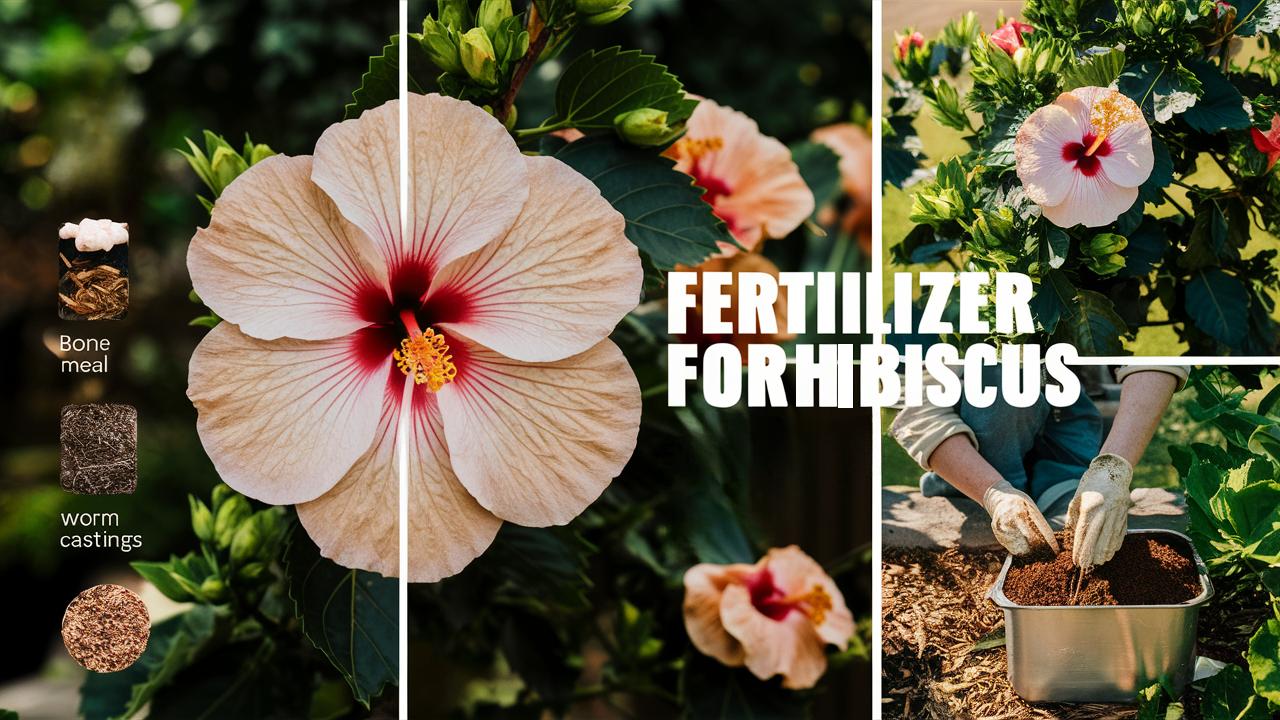In this comprehensive guide, we’ll explore the various aspects of hibiscus care, how to choose the right fertilizer, and tips for optimal results.
Fertilizer For Hibiscus
| Image | Name | Rating | Shop |
|---|---|---|---|
 | Tropical Bloom Fertilizer |  | |
 | Hibiscus Food |  | |
 | HIBISGAIN |  |
Tropical Bloom Fertilizer
Fertilome (11047) Hibiscus and Tropical Plant Food 17-7-10 (12 lbs.) is a specialist’s choice for promoting vibrant blooms on tropical flowering plants such as hibiscus.
This plant food contains a balanced blend of nitrogen, phosphate, potassium, and other essential nutrients that support the growth of colorful blooms. For best results, apply every other week until blooms begin to appear, then switch to application once per month during the blooming period. Always follow label instructions for specific guidance on application based on plant size and container type.
Hibiscus Fertilizer
The Hibiscus Plant Food 10-4-12 4 Lbs is a well-formulated fertilizer suitable for all hibiscus varieties. Its scientifically designed formula provides essential nutrients that promote healthy growth and flowering in hibiscus plants.
If you’re looking to give your hibiscus plant the best nutrient boost possible, this product should be on your list of top contenders. The addition of fritted trace elements ensures a balanced release of micronutrients, supporting overall health and preventing any potential deficiencies that may hinder optimal plant growth.
HibisGAIN
Folks looking to give their hibiscus plants the right kind of grow might want to take a long look at BGI’s HIBISGAIN. This fertilizer was specifically formulated for how hibiscus tend to do in different environments, making it something that could get results.
What makes this one stand out is that it was essentially developed by professional hibiscus growers in Homestead, FL – folks who’ve made a living from knowing what works with these plants. It’s also straightforward to use: just apply it right on top of the soil and mulch without needing to mess around with any complicated mixing or blending.
Hibiscus & Tropical Plant Food
The Hibiscus & Tropical Plant Food 4lb. Bag is a great choice for those looking to boost their hibiscus plant’s growth and flowering performance. With its fast-acting formula, you can expect to see results quickly.
This fertilizer is specifically designed with tropical plants in mind, and the ingredients are tailored to enhance size, color, and quality. The N-P-K ratio of 17-07-10, along with micronutrients like S, MG, FE, MN, ZN, and CU, provide a balanced diet for your hibiscus plant to thrive.
EarthPods Fertilizer for Tropical Plants
For those looking to give their Hibiscus plant a boost, I’d recommend considering ‘100 EarthPods – Bio Organic Hibiscus Fertilizer Spikes’. This premium fertilizer is specifically designed for tropical plants like Hibiscus and offers excellent results. The proprietary formula contains a variety of organic nutrients, trace minerals, soil life, and humates that are immediately available to the plant.
What I like about this product is its convenient and mess-free design. Simply push one EarthPod into the soil near the center of the plant, and then water as usual. The 100 Concentrated EarthPods provided in a single tube offer a 4-year supply for a single Hibiscus or can be used on multiple potted tropical flowers. Plus, this product is eco-friendly, compact, and made sustainably in the USA, making it a great choice for those looking to do their part for the environment.
Hibiscus Fertilizer
The TPS NUTRIENTS Hibiscus Fertilizer is a specifically designed plant food for hibiscus plants. If you’re looking to ensure your tropical and flowering hibiscus are healthy and thriving, this fertilizer can be a good choice.
Based on the product description provided, it seems like this fertilizer is formulated to cater to the unique needs of hibiscus plants. The fact that it’s termed ‘Hibiscus Fertilizer for Tropical and Flowering Plants’ directly aligns with its intended purpose – giving your hibiscus plant a boost it requires. As such, considering this specific formulation can be advantageous in getting desired hibiscus results.
Understanding Hibiscus Plants
Before delving into fertilizers, let’s familiarize ourselves with hibiscus plants. Belonging to the Malvaceae family, hibiscus plants encompass a diverse range of species, each boasting unique characteristics. They are popular in tropical and subtropical regions but can be grown indoors as houseplants in cooler climates. The most common types include the tropical hibiscus (Hibiscus rosa-sinensis) and the perennial hibiscus (Hibiscus moscheutos).
Hibiscus plants thrive in sunlight and well-draining soil, making them ideal for sunny borders or containers on patios. However, the key to vibrant foliage and prolific blooms lies within the nutrients they receive. This is where choosing the right fertilizer becomes a pivotal aspect of successful hibiscus growth.
Why Fertilization is Important for Hibiscus
Fertilizing hibiscus is essential for several reasons:
Nutrient Supply: Soil may not always have sufficient nutrients, especially in pots or new plantings. Fertilizers provide the necessary macro and micronutrients that hibiscus need for growth and flowering.
Encouraging Blooms: Hibiscus plants require a balance of nutrients to produce those iconic blossoms. An appropriate fertilizer can stimulate flowering and prolong the blooming season.
Improving Soil Quality: With continuous growth, soil can become depleted over time. Fertilizers help replenish essential nutrients and improve overall soil quality.
Enhancing Growth: Beyond just blooming, hibiscus also requires nutrients for leaf and stem growth. Proper fertilization promotes a well-structured plant that can withstand environmental stressors.
Identifying Hibiscus Nutritional Needs
To choose the best fertilizer for your hibiscus, first, it’s important to understand the specific nutritional needs of the plant. The primary macronutrients essential for hibiscus plants are nitrogen (N), phosphorus (P), and potassium (K):
Nitrogen (N): Vital for leaf growth and overall plant vigor. Nitrogen promotes lush green foliage.
Phosphorus (P): Essential for root development and flower production. Phosphorus encourages strong roots and boosts blooming activity.
Potassium (K): Important for overall plant health, potassium helps the plant resist disease and regulate water.
Alongside these macronutrients, hibiscus plants also require micronutrients such as magnesium, iron, and calcium in smaller quantities, which are equally important for optimal growth.
Types of Fertilizers for Hibiscus
When considering how to choose the best fertilizer for hibiscus, it’s crucial to understand the types available in the market. They can be broadly categorized into two main types: organic and synthetic fertilizers.
Organic Fertilizers
Organic fertilizers are derived from natural sources and can improve soil structure in addition to providing nutrients. Some popular options include:
Compost: Rich in nutrients, compost can provide a slow-release source of food for your hibiscus. It improves soil quality and maintains moisture.
Bone Meal: High in phosphorus, bone meal is excellent for encouraging blooming and rooting.
Fish Emulsion: This liquid fertilizer is nitrogen-rich and can promote leafy growth.
Kelp Meal: A great source of potassium and trace elements that help with plant health and growth.
Organic fertilizers tend to release nutrients slowly, providing a more sustained feeding that aligns well with the growth cycles of hibiscus.
Synthetic Fertilizers
Synthetic fertilizers offer immediate nutrient availability, which can be advantageous during the growing season. Common formulations include:
Balanced Fertilizers: A balanced N-P-K ratio (such as 10-10-10) can benefit general growth and flowering, providing equal parts of each nutrient.
Flowering Fertilizers: These formulations often have higher phosphorus content, such as a 5-10-5 mix, specifically designed to promote blooming.
Slow-Release Fertilizers: These are designed to provide nutrients over an extended period, reducing the frequency of applications and ensuring consistent nourishment.
Synthetic fertilizers can be effective for quick results, but caution is necessary to avoid over-fertilization, which can damage the plant.
Choosing the Right Fertilizer Based on Growth Stage
Understanding the growth stage of your hibiscus can significantly influence your fertilizer choice. The nutritional requirements will differ between a young plant, a mature hibiscus, and one that is in the blooming phase.
Young Hibiscus Plants
For younger hibiscus plants or newly transplanted specimens, focus on promoting root development and vigorous growth. A fertilizer rich in nitrogen is advisable, such as a balanced N-P-K mix like 10-10-10 or a slightly higher nitrogen formula (like 15-5-10).
Deploy organic options such as compost or fish emulsion to nurture young plants while ensuring healthy soil structure.
Mature Hibiscus Plants
Once your hibiscus plants are well-established and have entered a phase of vigorous growth, the focus should shift. Incorporating a balanced fertilizer that supports both foliage and root development is essential.
At this stage, a formula like 12-4-8 can provide enough nitrogen for leaf growth, while still delivering phosphorus and potassium for root development and plant health.
Blooming Hibiscus Plants
When it comes time for your hibiscus to bloom, adjust your fertilization strategy to encourage flowering. Higher phosphorus levels are important during this stage, which you can achieve through a specialized flowering fertilizer. Look for a formulation like 5-10-5 or even a water-soluble bloom booster.
Seasonal Considerations in Fertilization
The timing of your fertilizer application is equally critical as the type of fertilizer you choose. The growing season for hibiscus typically begins in spring and can continue through summer depending on your climate.
Spring Feeding: As temperatures rise and growth resumes, start fertilizing your hibiscus once a month with a balanced fertilizer. This early feeding encourages robust growth.
Summer Boost: As your plants begin to bloom, switch to a phosphorus-rich formula to support flowering. Apply every four to six weeks to maintain bloom production.
Fall Preparation: As autumn approaches and growth slows, reduce the frequency of fertilization. Stop fertilizing plants in late summer or early fall to allow them to harden off before winter.
Winter Care: If your hibiscus is indoors or in a mild climate, you may want to fertilize sparingly in winter, as plants typically enter a dormant phase. Incorporate a low-nitrogen formula or withhold fertilization until spring.
Application Methods for Hibiscus Fertilization
Once you’ve chosen the right fertilizer for your hibiscus, applying it correctly is crucial for optimal results. Here are the primary methods:
Granular Fertilizers
Granular fertilizers can be sprinkled around the base of the plant and should then be lightly worked into the soil. This method promotes slow and steady nutrient release as the soil absorbs moisture.
Tips:
Water the plant thoroughly before applying granular fertilizers to prevent root burn.
Follow the package instructions carefully concerning the amount to apply.
Liquid Fertilizers
Liquid fertilizers can provide quick nutrient uptake and are great for immediate results. Diluting them with water according to the product instructions allows you to provide nourishment during the growing season more frequently.
Tips:
Apply liquid fertilizers during watering to avoid excess concentration in one area, which can harm the roots.
Be cautious not to over-fertilize; more frequent small doses are often better than large infrequent applications.
Fertilizer Stake
For long-term nourishment, you can use fertilizer stakes that you insert into the soil near the root zone. These slowly release nutrients throughout the growing season.
Tips:
Choose biodegradable stakes that can improve soil structure over time.
Follow the manufacturer’s recommendations for the number of stakes to use based on the size of the plant.
Signs of Nutrient Deficiency in Hibiscus
Effective fertilizer management is also about being observant. Knowing the signs of nutrient deficiency can help you adjust your fertilizer choice and application. Common deficiency symptoms include:
Yellowing Leaves: Often a sign of nitrogen deficiency. When older leaves turn yellow while the veins remain green (“chlorosis”), it’s time to boost the nitrogen intake.
Poor Blooms: Low phosphorus can lead to fewer flowers or smaller blooms. If your plant is growing but not flowering, consider a phosphorus-rich fertilizer.
Stunted Growth: If your hibiscus’s growth appears stunted, it may need a balanced fertilizer or additional potassium which aids in overall health and resilience.
Container vs. Garden Hibiscus Fertilization
Whether your hibiscus is in pots or directly in the ground can influence your fertilization strategy. Container plants often benefit from more frequent fertilization due to limited soil volume, which can lose nutrients quickly through drainage.
Container Care
In pots, consider the following:
Use a higher frequency of feeding, approximately every 4-6 weeks during the growing season.
Switch to a water-soluble fertilizer to ensure nutrients are available immediately.
Monitor for signs of nutrient deficiency more closely, as the limited soil means a faster depletion of nutrients.
Garden Care
For hibiscus planted in the ground:
Apply an annual dose of organic compost in spring to enhance soil structure and nutrients.
Utilize slow-release granular fertilizers that will work throughout the growing season.
Apply mulch to maintain soil moisture and improve nutrient retention.
Environmental Considerations
Consider the broader environmental implications of fertilizer use. Over-fertilization can lead to nutrient runoff, negatively impacting local ecosystems and water quality. Following best practices in fertilization will promote a healthier garden while also being responsible stewards of the environment.
Use fertilizers sparingly and based on the needs of the plant.
Opt for organic fertilizers whenever possible to minimize environmental impact.
Regularly test your soil to ensure you are not adding unnecessary nutrients.
Conclusion
Choosing the best fertilizer for hibiscus can feel overwhelming with all the options available. However, by understanding your hibiscus plants’ needs, the types of fertilizers on the market, and how to apply them correctly, you can nurture your hibiscus to thrive. Whether you’re aiming for lush foliage or breathtaking blooms, the right fertilization strategy will make all the difference.








